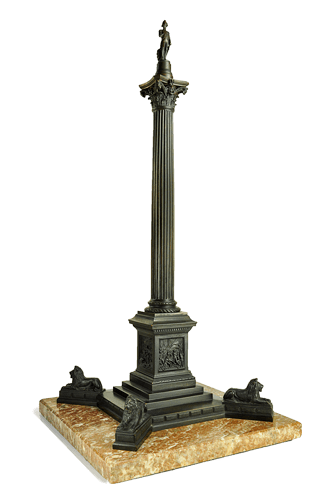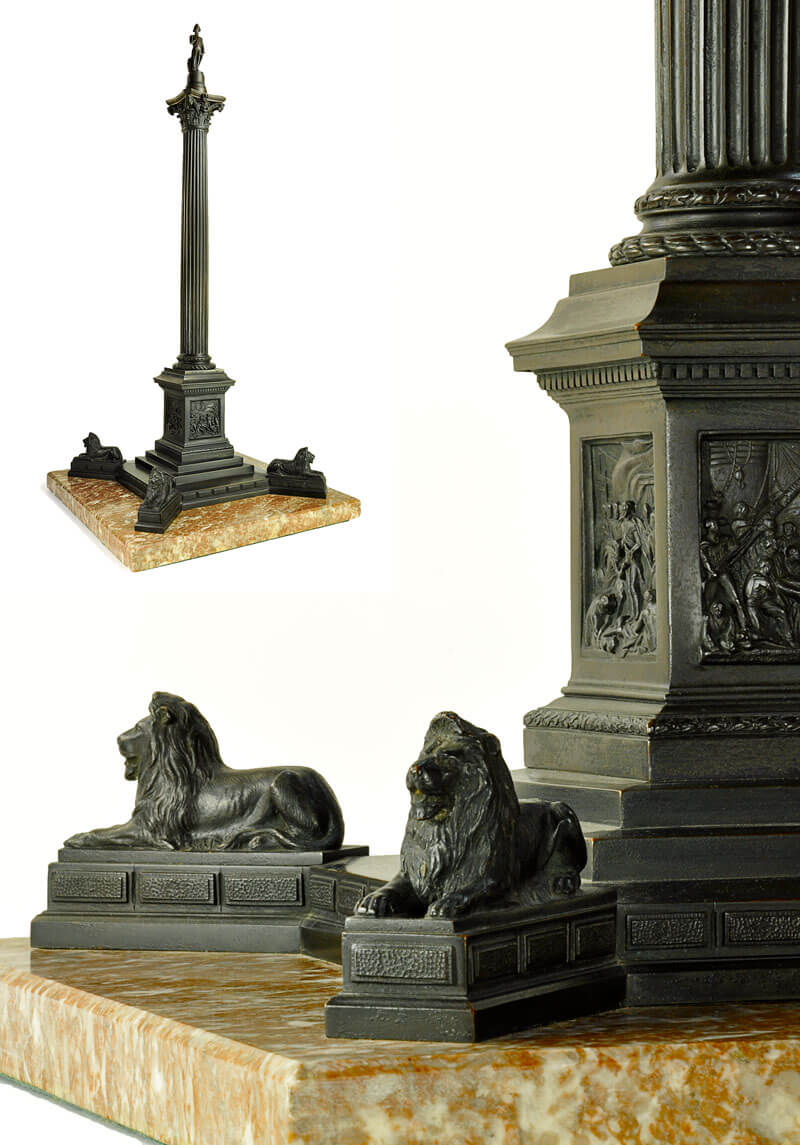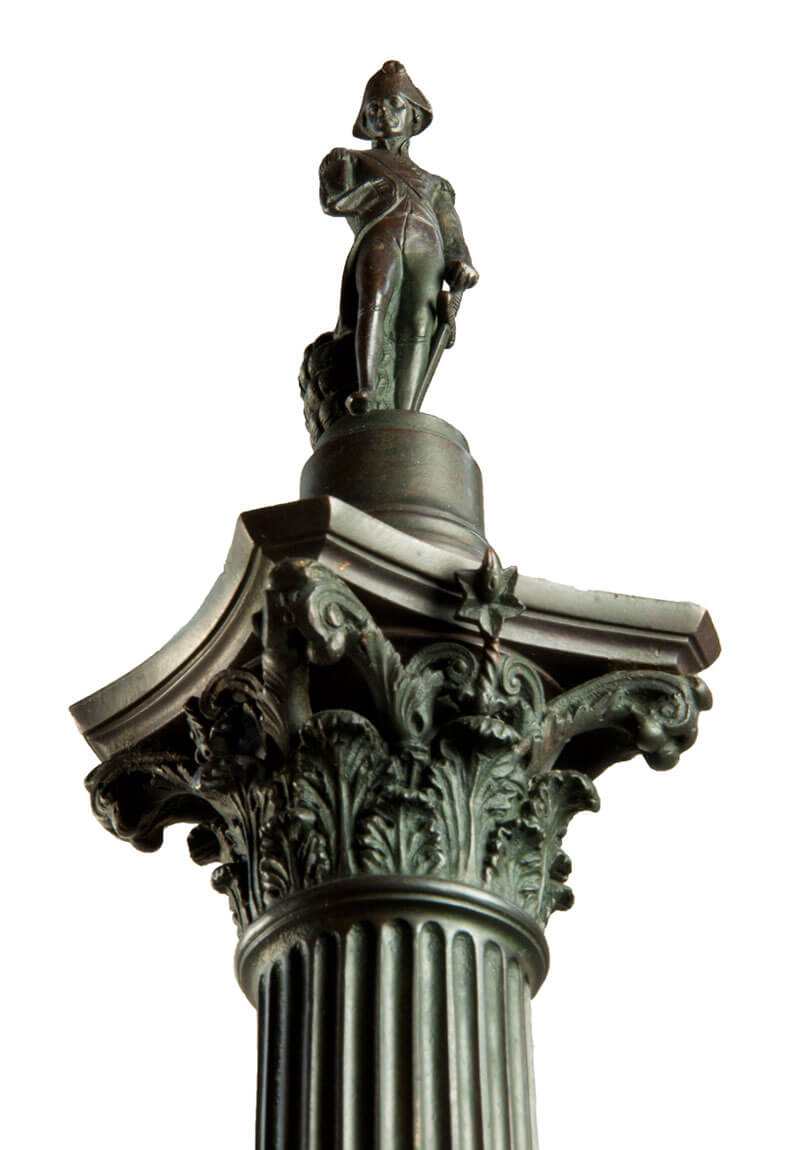
Nelson’s Column, London
dark-patinated bronze & granite, 26″ h
produced by the Art Union of London
original model by W. F. Woodington
replica by Giovanni Franchi, 1 of 25, 1868
Famously dissatisfied with the tributes (and more tangible expressions of gratitude) received during his lifetime, Admiral Horatio Lord Nelson (1758 – 1805) might have been genuinely pleased at the erection, in London, between 1841 and 1843, of the 169 foot tall stone column memorializing him and his heroic naval victories over Napoleon’s fleet and others, at a time when Britain’s survival was an open question. The column, patterned on that of Trajan, in Rome, is a robust landmark, impossible to overlook. (Among those who admired Nelson’s Column was Hitler, whose plans for the invasion of Britain including making off with the tall stone pillar, and re-assembling it in Berlin).
Still, the Admiral would have questioned why it required 34 years from his death at the Battle of Trafalgar, until architect William Railton’s winning the design competition for the monument in 1839. And disappointment would have greeted the decision to shorten the monument from its originally proposed height of 203 feet, in order to meet the budget.
Despite his predilection for dramatizing self-aggrandizement – a trait shared by military celebrities throughout history – it is not difficult here to side with Nelson. He’d given so much of himself – his right eye at the Battle of Calvi in Corsica; his right arm at the Battle of Santa Cruz de Tenerife; and, of course, his life in the Battle of Trafalgar, against the combined French and Spanish fleets, an engagement in which British forces were significantly outnumbered.
On the other hand, Nelson’s tactics, including disobeying orders, or ‘misinterpreting’ them, led to some upper crust opprobrium. The phrase ‘turn a blind eye’ originated in Nelson’s holding up a telescope to his right (blind) eye during a sea battle, then declaring he saw nothing standing in the way of his ships advancing.
And there was his notorious relationship with Emma Hamilton (1765 – 1815), wife of William (1731-1803), British ambassador to Naples, collector and aesthete. Nelson was, there is not another word for it, smitten with Emma, quick-witted and a great beauty – she was a favorite subject of English painter George Romney. Nelson, despite his 11 year marriage to wife Fanny, was all in. Interestingly, so, it appears, was William, whose mother had been mistress to the Prince of Wales and whose wife, Emma, 34 years younger than he, had been mistress to William’s nephew.
In 1799, the three of them – they called themselves the “Tria juncta in uno” – left Naples, then under threat of French invasion; and took up residence in Palermo, Italy. By 1800, Emma was pregnant (her and Horatio’s daughter was to be named Horatia), and the Tria headed home to England, celebrated at every stop along the way. Official distaste was no match for the public’s enthusiasm (and curiosity).
What does this have to do with the offered model of Nelson’s Column? Nearly nothing, except to suggest Nelson’s critical role in the public (rather than official) imagination, a role which led (slowly) to the putting up of a great monument, and eventually to the production of its miniature.
Where were we?
This very finely-detailed, bronze replica was sponsored by the Art Union of London, established in 1837, whose goal –“to aid in extending the love of the Arts of Design throughout the United Kingdom, and to give encouragement to Artists” – was met through a subscription scheme and distribution of prizes – modest works of Art – via lottery. In 1868, the Union’s Report of the Committee of Management recorded that “Mr. W. F. Woodington, one of the artists engaged to model the bas-reliefs on the base of the Nelson Column, has prepared an exact copy of the monument on a scale of 1/7 in. to the foot, and copies in bronze, executed by Mssrs. Franchi, will form part of the prize. The account later advises there will be “25 Bronzes of the Nelson Column”. The timing of the Art Union’s interest may have been inspired by the addition to the monument’s base, a year earlier (1867), of four large, Edwin Landseer – designed lions (part of Railton’s original 1839 plan).
William F. Woodington’s (1806 – 1893) large, bronze, bas-relief – the Battle of the Nile – joined three other identically sized plaques at the Column’s pedestal, each fashioned by a different sculptor, including the Battle of St. Vincent, Bombardment of Copenhagen, and Death of Nelson. Woodington’s work on the Art Union model is all precision.
The “Mssrs. Franchi” mentioned in the Art Union Report … were undoubtedly Giovanni Franchi (1811-1874) and his son (1832-1870). This London company specialized in electrotype – “the only electrotypist(s) who devote themselves exclusively to Fine Art”, reported the Art Journal (1866). The company was acquired in 1874 by the British behemoth silver manufacturer Elkington & Co., who were devoted to profit.
By 1876, Art Union membership had swelled to 20,000, testimony to their successes in “extending the love of the Arts of Design”; as well as their marketing scheme. Who doesn’t like to win a prize? And yet, 20 years later, challenged by new methods of delivering Art to an increasingly receptive public, the Union counted fewer than 5,000 subscribers, before disbanding in 1912.






